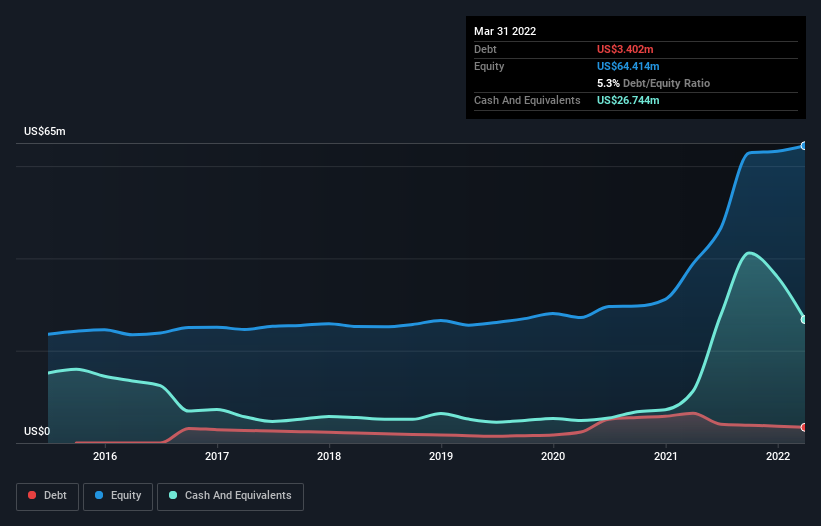- United States
- /
- Healthcare Services
- /
- NasdaqCM:SMED
Is Sharps Compliance (NASDAQ:SMED) Using Too Much Debt?

David Iben put it well when he said, 'Volatility is not a risk we care about. What we care about is avoiding the permanent loss of capital.' So it seems the smart money knows that debt - which is usually involved in bankruptcies - is a very important factor, when you assess how risky a company is. We can see that Sharps Compliance Corp. (NASDAQ:SMED) does use debt in its business. But should shareholders be worried about its use of debt?
Why Does Debt Bring Risk?
Debt and other liabilities become risky for a business when it cannot easily fulfill those obligations, either with free cash flow or by raising capital at an attractive price. Ultimately, if the company can't fulfill its legal obligations to repay debt, shareholders could walk away with nothing. However, a more common (but still painful) scenario is that it has to raise new equity capital at a low price, thus permanently diluting shareholders. Of course, plenty of companies use debt to fund growth, without any negative consequences. The first step when considering a company's debt levels is to consider its cash and debt together.
See our latest analysis for Sharps Compliance
What Is Sharps Compliance's Net Debt?
The image below, which you can click on for greater detail, shows that Sharps Compliance had debt of US$3.40m at the end of March 2022, a reduction from US$6.45m over a year. But on the other hand it also has US$26.7m in cash, leading to a US$23.3m net cash position.

A Look At Sharps Compliance's Liabilities
We can see from the most recent balance sheet that Sharps Compliance had liabilities of US$14.8m falling due within a year, and liabilities of US$14.1m due beyond that. Offsetting this, it had US$26.7m in cash and US$14.8m in receivables that were due within 12 months. So it can boast US$12.6m more liquid assets than total liabilities.
It's good to see that Sharps Compliance has plenty of liquidity on its balance sheet, suggesting conservative management of liabilities. Given it has easily adequate short term liquidity, we don't think it will have any issues with its lenders. Simply put, the fact that Sharps Compliance has more cash than debt is arguably a good indication that it can manage its debt safely.
Importantly, Sharps Compliance's EBIT fell a jaw-dropping 90% in the last twelve months. If that decline continues then paying off debt will be harder than selling foie gras at a vegan convention. When analysing debt levels, the balance sheet is the obvious place to start. But it is future earnings, more than anything, that will determine Sharps Compliance's ability to maintain a healthy balance sheet going forward. So if you're focused on the future you can check out this free report showing analyst profit forecasts.
Finally, while the tax-man may adore accounting profits, lenders only accept cold hard cash. Sharps Compliance may have net cash on the balance sheet, but it is still interesting to look at how well the business converts its earnings before interest and tax (EBIT) to free cash flow, because that will influence both its need for, and its capacity to manage debt. In the last three years, Sharps Compliance's free cash flow amounted to 28% of its EBIT, less than we'd expect. That weak cash conversion makes it more difficult to handle indebtedness.
Summing up
While we empathize with investors who find debt concerning, you should keep in mind that Sharps Compliance has net cash of US$23.3m, as well as more liquid assets than liabilities. So we don't have any problem with Sharps Compliance's use of debt. There's no doubt that we learn most about debt from the balance sheet. But ultimately, every company can contain risks that exist outside of the balance sheet. For instance, we've identified 6 warning signs for Sharps Compliance that you should be aware of.
If you're interested in investing in businesses that can grow profits without the burden of debt, then check out this free list of growing businesses that have net cash on the balance sheet.
New: Manage All Your Stock Portfolios in One Place
We've created the ultimate portfolio companion for stock investors, and it's free.
• Connect an unlimited number of Portfolios and see your total in one currency
• Be alerted to new Warning Signs or Risks via email or mobile
• Track the Fair Value of your stocks
Have feedback on this article? Concerned about the content? Get in touch with us directly. Alternatively, email editorial-team (at) simplywallst.com.
This article by Simply Wall St is general in nature. We provide commentary based on historical data and analyst forecasts only using an unbiased methodology and our articles are not intended to be financial advice. It does not constitute a recommendation to buy or sell any stock, and does not take account of your objectives, or your financial situation. We aim to bring you long-term focused analysis driven by fundamental data. Note that our analysis may not factor in the latest price-sensitive company announcements or qualitative material. Simply Wall St has no position in any stocks mentioned.
About NasdaqCM:SMED
Sharps Compliance
Sharps Compliance Corp. provides medical, pharmaceutical, and hazardous waste management services in the United States.
Flawless balance sheet and fair value.
Market Insights
Community Narratives




